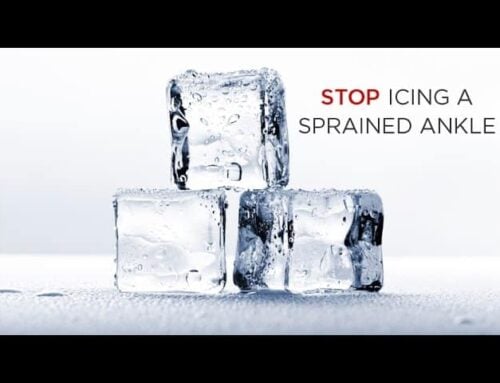
Sprained ankles are not just common injuries among athletes but also frequently occur in daily activities. Understanding the nuances of a sprained ankle and swelling, including the reasons behind swelling, the duration of swelling, and effective management strategies, is crucial for proper healing and prevention of future injuries.
Swelling in a sprained ankle is primarily caused by the body’s natural response to injury. When an ankle is sprained, the ligaments that support the joint are stretched or torn, triggering a series of physiological responses:
- Inflammatory Response: When ligaments are damaged, the body initiates an inflammatory response. This involves the release of various chemicals and white blood cells to the injured area to start the healing process. This response increases blood flow to the area, which can result in redness, warmth, and swelling.
- Fluid Accumulation: The increase in blood flow, combined with the release of inflammatory chemicals, causes the small blood vessels (capillaries) in the area to become more permeable. This allows fluid to leak into the surrounding tissues, leading to swelling. The accumulation of this fluid (edema) helps to immobilize the joint and provides a cushioning effect to protect the area from further injury.
- Bruising: In some cases, the injury to the ankle can also cause rupturing of small blood vessels. This can lead to bruising and additional swelling, as blood and other fluids accumulate in the tissue spaces around the joint.
- Pain and Reflexive Muscle Spasms: Pain from the injury and the subsequent swelling can also lead to reflexive muscle spasms in the surrounding area. These spasms can further contribute to the swelling by compressing blood vessels and limiting fluid drainage.
- Joint Effusion: Sometimes, the trauma to the ankle joint can lead to a condition known as joint effusion, where excess joint fluid (synovial fluid) accumulates in or around the joint capsule, adding to the swelling.
It’s important to manage a sprained ankle and swelling swelling effectively as part of the healing process. People typically recommend rest, ice, compression, and elevation (RICE) for a sprained ankle and swelling, but recent research has found this to be ineffective… more on thiathere >> Does RICE Work?
The key to understand is that swelling is an important part of the healing process, so the fastest way to heal is to support your body. This not only speeds up the healing process, but also improves the quality by which you heal. The goal is to heal quickly, but also have strong ankles that are at a reduced risk of re-injury. To learn more about this, please check out HEM Ankle Rehab.
How Long Can a Sprained Ankle Be Swollen?
Ankle injuries are common, and usually come in the form of a sprained ankle and swelling. The duration of swelling after a sprain can vary significantly, typically depending on the severity of the injury.
For mild sprains, swelling might reduce within a few days to a week. However, in more severe cases, swelling can persist for several weeks or even months. It’s essential to note that everyone’s healing process is different, and various factors like age, general health, and the body’s response to injury can influence recovery time.
Here’s a closer look at what to expect after you get a sprained ankle and swelling occurs:
- Mild Sprains (Grade 1): In these cases, slight stretching and microscopic tearing of the ligaments occur. Swelling and discomfort are typically mild and can subside within a week or two.
- Moderate Sprains (Grade 2): This involves a partial tearing of the ligament. Swelling in such cases can be more pronounced and might take several weeks to reduce.
- Severe Sprains (Grade 3): This is a complete tear of the ligament. Swelling can be significant and persistent, often lasting for months. In such cases, medical intervention, including physical therapy, might be necessary for complete recovery.
Why Does My Sprained Ankle Still Look Swollen?
If have a sprained ankle and swelling remains after an expected period of healing, it could be due to several reasons. Persistent swelling might indicate a more severe sprain than initially diagnosed, or it could be a sign of inadequate rest and recovery post-injury. In some cases, continuous swelling can also result from complications such as a misalignment of ankle bones, development of scar tissue, or even a secondary injury. Ensuring proper diagnosis and following a tailored recovery plan is crucial for effective healing.
It’s crucial to understand the potential causes of why:
- Inadequate Rest and Rehabilitation: Not giving your ankle enough time to heal or resuming activities too soon can prolong swelling.
- Chronic Instability: Repeated sprains can lead to chronic ankle instability, making the ankle more susceptible to swelling.
- Complications: In some cases, complications like a fracture, deep vein thrombosis, or a torn tendon can mimic or exacerbate a sprained ankle and swelling.
What are Four Signs an Ankle Sprain is Bad?
Identifying a severe ankle sprain is crucial for appropriate treatment. Here are four signs that your ankle sprain might be severe:
- Intense Pain: While pain is common in sprains, severe cases often result in unbearable pain, especially when putting weight on the affected foot.
- Significant Swelling and Bruising: If you had a sprained ankle and swelling is extensive, with deep bruising… these are indicators of significant tissue damage.
- Limited Range of Motion: Difficulty moving the ankle or an inability to bear weight is a telltale sign of a severe sprain.
- Deformity or Instability: If your ankle looks deformed or feels unusually unstable, it might indicate torn ligaments or even a fracture.
In addition to intense pain, significant swelling, limited range of motion, and instability or deformity, there are other indicators:
- Audible Popping Sound: Hearing a popping sound at the injury time can indicate a severe sprain or ligament rupture.
- Persistent Discomfort: Pain that doesn’t improve with standard home care treatments could signify a more severe injury.
- Recurring Swelling: If you had a sprained ankle and swelling recurs or persists even after initial improvement, it might indicate underlying issues.
- Change in Skin Color: If the skin around the ankle turns pale, bluish, or feels unusually cold, it could suggest a circulation problem requiring immediate attention.
When Should I Be Worried About a Sprained Ankle?
It’s crucial to monitor your sprained ankle for signs that warrant professional medical attention. Consult a healthcare provider if you experience:
- Severe pain and swelling that doesn’t improve with rest and ice.
- Inability to walk or bear weight on the ankle.
- Numbness or tingling in the ankle or foot.
- No improvement after several days of self-care.
While mild to moderate sprains typically heal with self-care, especially with a good at home rehab program, certain symptoms should prompt immediate medical attention:
- Severe or Worsening Symptoms: If pain, swelling, or bruising significantly worsens or doesn’t improve.
- Inability to Walk: Difficulty in bearing any weight or walking more than a few steps without significant pain.
- Altered Sensation: Experiencing numbness, tingling, or a complete lack of sensation in the ankle or foot.
- No Improvement Over Time: Lack of improvement or worsening of symptoms over the first few days following the injury.
Optimizing Your Recovery
Recovery from a sprained ankle involves MUCH more than just rest and ice. It’s about understanding the right balance between rest, rehabilitation exercises, and when to seek further medical advice. For those looking to expedite their recovery, consider exploring comprehensive rehab programs like HEM Ankle Rehab. Such programs can offer tailored guidance and exercises designed to reduce swelling, improve strength, and enhance mobility in a safe and effective way.
Conclusion
Dealing with a sprained ankle can be challenging, but understanding the nuances of your injury, how to care for it, and when to seek help can make a significant difference in your recovery journey.
Remember, each injury is unique, so listen to your body and don’t rush the healing process.
Secret of the Pros
Everything You Need To Heal At Home
So, Why Rehab?
Most people think rest and ice will heal their ankle (even a severe sprain), but they end up with chronic ankle instability… 30% still have pain one year later!
And that causes all kinds of muscle imbalances in the body, which can lead more serious injuries, repeated ankle sprains and chronic ankle pain. It’s a terrible domino effect that can last for life.
That’s Where Rehab Comes In.
A great rehab program significantly improves how a sprained ankle heals. It eliminates pain fast and ensures your ankles are strong and stable with healthy range of motion, which helps prevent future sprains.
Rehab Is The Key To
Healing Ankle Injuries Fast
Recent studies have shown that rehab heals ankle ligaments safely and effectively. It’s the difference between the people that don’t heal a sprained ankle and the ones that do!
Injured Ankle
Without Rehab
Injured Ankle
With Rehab
HEM Ankle Rehab “Rehabs” Your Ankle

HEM is a complete ankle rehab and prehab program for the entire ankle, foot and calf complex. This is a very thorough program that contains so much more than anything else you can find online, but it’s still easy to do.
Scott will coach you through every step, as if you are with him, one on one. Just follow along with the videos to rebuild your ankle from the ground up.
You can expect pain free mobility and strong, stable ankles that are protected from an ankle sprain, without ankle braces!
REAL PEOPLE, REAL RESULTS
From Scott Malin, NASM-CPT, CES
Creator, HEM Ankle Rehab
October 07, 2025
Fifteen years ago, I had to give up what I love doing most… playing basketball. I sprained my ankles so many times that I could no longer play. It was devastating.
Like you, I used R.I.C.E. (rest, ice elevation, compression), but my ankles healed so slowly and badly, they eventually got so weak, I would sprain them just walking down the street!
Being a fitness trainer, the only thing I had going for me was a fascination with helping people get out of pain and strengthening their bodies.
So, I decided to research all the cutting edge techniques to heal an ankle sprain much faster and better than R.I.C.E.
After months of research, I discovered that icing an injury can have a negative affect on the body’s healing process. Studies show that ice can actually slow down healing and too much rest left the ankles weak and unstable. This was shocking, but only part of the story…
New research was suggesting a much more proactive approach to healing that involved much better rehab techniques proven to dramatically speed up the speed and quality of the healing process.
Instead of months, healing took only days. And, if you had a chronically weak ankle that was in pain, these techniques would quickly strengthen and stabilize the ankles.
I kept improving on these techniques, drawing from many different disciplines and simplified them.
Eventually, after many more months of trial and error, I created a simple at-home healing system with very reliable results.
Since I was a fitness trainer, I was able to help all my clients (celebrities and athletes) whenever they got injured. I was even on the news a few times.
The response from my clients and friends was so overwhelming that a few of them eventually convinced me to share it with everyone.
Today, I am humbled that over 100,000 people have healed fully and fast with my program.
So, if you have any kind of ankle injury (new or old), just follow along with me in the videos and I’ll show you exactly what to do until you are completely pain free.
My message is simple… you do not have to give up what you love. And you do not have to live with chronic pain from old injuries. Life is too short and there is a better way!
I truly hope you will start using my program so you can get your life back and do what you love, pain free (and yes, I still play basketball every week and LOVE it!)
Thank you!
Scott
Heal Your Ankle FAST ⇣

30 day money back guarantee
15 YEARS. 100K HEALED.

Secret of the Pros
Everything You Need To Heal At Home
REAL PEOPLE,
REAL RESULTS
So, Why Rehab?
Most people think rest and ice will heal their ankle (even a severe sprain), but they end up with chronic ankle instability… 30% still have pain one year later!
And that causes all kinds of muscle imbalances in the body, which can lead more serious injuries, repeated ankle sprains and chronic ankle pain. It’s a terrible domino effect that can last for life.
That’s Where Rehab Comes In.
A great rehab program significantly improves how a sprained ankle heals. It eliminates pain fast and ensures your ankles are strong and stable with healthy range of motion, which helps prevent future sprains.

Rehab Is The Key To
Healing Ankle Injuries Fast
Recent studies have shown that rehab heals ankle ligaments safely and effectively. It’s the difference between the people that don’t heal a sprained ankle and the ones that do!
Injured Ankle
Without Rehab
Injured Ankle
With Rehab
HEM Ankle Rehab
“Rehabs” Your Ankle

HEM is a complete ankle rehab and prehab program for the entire ankle, foot and calf complex. This is a very thorough program that contains so much more than anything else you can find online, but it’s still easy to do.
Scott will coach you through every step, as if you are with him, one on one. Just follow along with the videos to rebuild your ankle from the ground up.
You can expect pain free mobility and strong, stable ankles that are protected from an ankle sprain, without ankle braces!
100,000 PEOPLE HEALED-
-
-
-
-
-
-
-
-
-
-
-
-
-
-
-
-
-
From Scott Malin, NASM-CPT, CES
Creator, HEM Ankle Rehab
October 07, 2025
Fifteen years ago, I had to give up what I love doing most… playing basketball. I sprained my ankles so many times that I could no longer play. It was devastating.
Like you, I used R.I.C.E. (rest, ice elevation, compression), but my ankles healed so slowly and badly, they eventually got so weak, I would sprain them just walking down the street!
Being a fitness trainer, the only thing I had going for me was a fascination with helping people get out of pain and strengthening their bodies.
So, I decided to research all the cutting edge techniques to heal an ankle sprain much faster and better than R.I.C.E.
After months of research, I discovered that icing an injury can have a negative affect on the body’s healing process. Studies show that ice can actually slow down healing and too much rest left the ankles weak and unstable. This was shocking, but only part of the story…
New research was suggesting a much more proactive approach to healing that involved much better rehab techniques proven to dramatically speed up the speed and quality of the healing process.
Instead of months, healing took only days. And, if you had a chronically weak ankle that was in pain, these techniques would quickly strengthen and stabilize the ankles.
I kept improving on these techniques, drawing from many different disciplines and simplified them.
Eventually, after many more months of trial and error, I created a simple at-home healing system with very reliable results.
Since I was a fitness trainer, I was able to help all my clients (celebrities and athletes) whenever they got injured. I was even on the news a few times.
The response from my clients and friends was so overwhelming that a few of them eventually convinced me to share it with everyone.
Today, I am humbled that over 100,000 people have healed fully and fast with my program.
So, if you have any kind of ankle injury (new or old), just follow along with me in the videos and I’ll show you exactly what to do until you are completely pain free.
My message is simple… you do not have to give up what you love. And you do not have to live with chronic pain from old injuries. Life is too short and there is a better way!
I truly hope you will start using my program so you can get your life back and do what you love, pain free (and yes, I still play basketball every week and LOVE it!)
Thank you!
Scott
Hurry, sale ends soon!
30 day money back guarantee



























